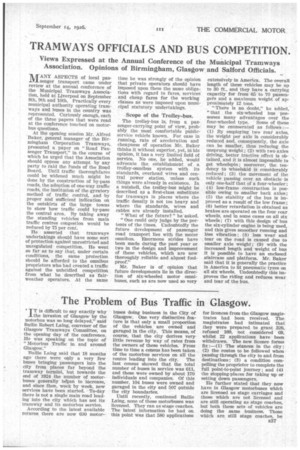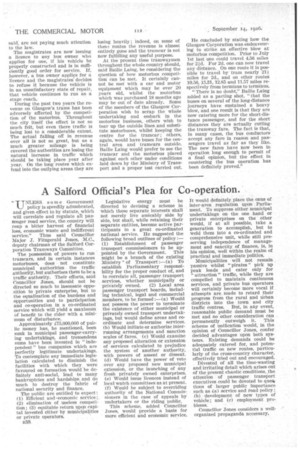The Problem of Bus Traffic in Glasgow.
Page 55

Page 56

If you've noticed an error in this article please click here to report it so we can fix it.
TT is difficult to say exactly why the invasion of Glasgow by the motorbus was so long delayed," said Bailie Robert Laing, convener of the Glasgow Tramways Committee, on the opening day of the conference. He was speaking on the topic of "Motorbus Traffic in and around Glasgow."
Bailie Laing said that 18 months ago there were only a very few buses bringing passengers into the city from places far beyond the tramway termini, but towards the end of 1924 the number of motorbuses generally began to increase, and since then, week by week, new services have been started. To-day there is not a single main road leading into the city which has not its tramway and its motorbus service.
According to the latest available returns there are now 600 motor buses doing business in the City of Glasgow. One very distinctive feature is that only a small proportion of the vehicles are owned and garaged in the city. This means, of course, that the city derives verylittle revenue by way of rates from the owners of these vehicles. From time to time a census has been taken of the motorbus services on all the routes leading into the city. The last census showed that the total number of buses in service was 611, and these were owned by about 170 individuals and companies. Of this number, 104 buses were owned and garaged in the city and 507 outside the city boundaries.
Until recently, continued Bailie Laing, none of these motorbuses was licensed. They ran as stage coaches. The latest information he had on this point was that 580 applications
for licences from the Glasgow magistrates had been received. The magistrates had intimated that they were prepared to grant 326, refused 169, not considered 69, whilst 22 applications have been withdrawn. The new licence forms fix :—(1) The stances in the city ; (2) the routes to be followed when passing through the city to and from destinations; (3) a condition compelling the proprietor to complete the full point-to-point journey ; and (4) the stopping-places for taking up or setting down passengers.
He further stated that they now have in Glasgow motorbuses which are licensed as stage carriages and those which are not licensed and are still operating as stage coaches, but both these sets of vehicles are doing the same business. Those which are still stage coaches, he said, are not paying much attention to the law.
The magistrates are now issuing a licence to any bus owner who applies for one, if his vehicle be properly constructed and is in suit.cient/y good order for service. If, however, a bus owner applies for a licence and the, magistrates decides to refuse it because the vehicle is In an unsatisfactory state of repair, that vehicle continues to run as a stage coach.
During the past two years the revenue on Glasgow's trams has been adversely affected by the competition of the motorbus. Throughout the city itself the effect is not so much felt, but even there traffic is being lost to a considerable extent. The actual falling off in revenue over all is not so great, but as a much greater mileage is being covered the authorities are losing the natural increase in traffic which should be taking place year after year. On the long routes which extend into the outlying areas they are losing heavily ; indeed, on some of these routes the revenue is almost entirely gone and the tramcar is not now fulfilling any useful purpose.
At the present time traniwaymen throughout the whole country should, said Bailie Laing, be considering the question of how motorbus competition can be met. It certainly cannot be met with a car and motor equipment which may be over 20 years old, whilst the motorbus which was purchased 18 months ago may be out of date already. Some of the members of the Glasgow Corporation wish to scrap the whole undertaking and embark in the motorbus business, others wish to tear up the outside lines and substitute motorbuses, whilst keeping the centre for the tramcar ; others, again, would have buses for the central area and tramcars outside. Bailie Laing would prefer to see the tramcar and the motorbus placed against each other under conditions laid down by the Ministry of Transport and a proper test carried out. He concluded by stating how the Glasgow Corporation was endeavouring to strike an effective blow at motorbus competition. Prior to July 1st last one could travel 4.56 miles for 2id. For 2d. one can now travel any distance., On one route it is possible to travel by tram nearly 211f miles for 2d., and on other routes 19.56, 15.31, 12.85 and 11.57 miles respectively from terminus to terminus.
"There is no doubt," Bailie Laing added as a parting shot, "that the buses on several of the long-distance journeys have sustained a heavy blow, and one result is that they are now catering more for the short-distance passenger, and for the short distances they are actually cutting the tramway fare. The fact is that, in many cases, the bus conductors accept any fare in reason and passengers travel as far as they like. The new fares have now been in operation long enough to permit of a final opinion, but the effect in countering the bus operation has been definitely proved."




































































































